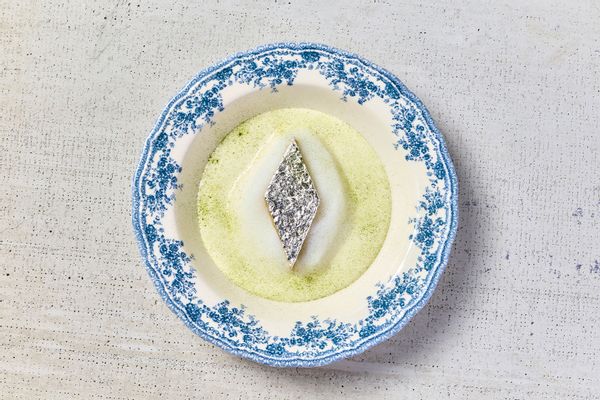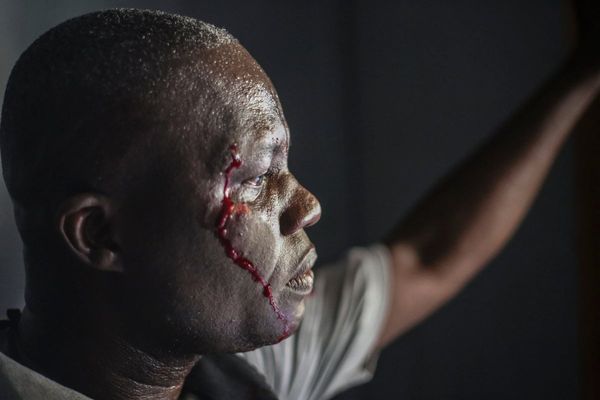
Chef Sujan Sarkar is on a mission to redefine what Indian food looks and tastes like. Within the States, in particular, the cuisine has garnered an erroneous reputation for solely consisting of just curries or meals saturated with oil. But that is far from the truth.
Sarkar — who grew up in India and later, found himself in an array of prestigious kitchens across London and Dubai — has been at the forefront of pioneering modern Indian cuisine for the past 20-plus years. To him, modern food isn’t a mere trend nor is it defined strictly as fusion cuisine. It’s food that pushes the boundaries of art and aesthetics while still remaining true to its traditional flavors. It’s paying homage to the rich history and vibrant stories tied to specific ingredients that ultimately make up a finished meal.
Sarkar is doing exactly that at four of his current establishments: Swadesi, Baar Baar (both in New York City and Los Angeles), Indienne and Tiya, his latest restaurant. At Swadesi, Sarkar serves up a Samosa Chaat Croissant filled with spiced potatoes and peas alongside a Butter Chicken Croissant that features burrata and red pepper makhani. At Baar Baar, Sarkar flaunts Brie Pakora, Jackfruit Biryani and Stuffed Malai Mushrooms. At Indienne, Sarkar is known for his Lamb Chop Burrah and Mishti Doi Tart.
Those are just a few of Sarkar’s culinary creations. The esteemed chef was a finalist at this year’s James Beard Award in the “Best Chef: Great Lakes” category. He was named on CS Magazine’s 2024 “Power List” and previously voted Times of India’s “Chef of the Year.”
I spoke with Sarkar shortly after visiting his food tent in partnership with Shan Foods at Smorgasburg. We discussed his illustrious culinary journey, his deep love for fashion and his favorite Diwali dishes.
The following interview has been lightly edited for clarity and length.
Tell me about your culinary journey. How did you get into cooking? And how did you decide that cooking was something that you wanted to pursue as a career?
I was born and raised in India — in Calcutta. After high school, I was aspiring to be a fashion designer, so I was trying my best to get into the top fashion school in India. That didn’t happen. I kind of accidentally got into culinary school. After I finished culinary school, I got into big hotels and from then, I realized, that cooking can be an alternative career path.
I worked in India for a bit after I finished my culinary school, then I moved to London and that's where everything kind of came into play, I would say. I started working with top chefs. I got the opportunity to work in different restaurants as well to understand how French cuisine works. I later got into modern European and French cooking. I did that for 13 years. Back in 2012, after spending almost 11 years in London, I moved back to India to learn more about Indian food — just going back to my roots. I wanted to learn more about the original Indian cooking. That's why I went back to India and picked up a job. At the same time, I was traveling around and learning more. I also planned to open up my first restaurant. I got an opportunity from Dubai to open a fine dining, modern Indian restaurant. That was something I’ve always wanted to do. When the restaurant settled, I moved back to India and opened my first Indian cocktail bar with Indian tapas. That was one of the first cocktail bars. Before that, there was no Indian cocktail bar as such.
In 2015, I opened Ek Bar (which translates to “one time”) and I ran that bar for more than a year. I then moved to San Francisco to help open Rooh. Eventually, I opened five Roohs all over the country: four in the United States and one in New Delhi. In between when I was working at Rooh, I also opened Baar Baar (which translates to “over and over again”) in New York in December 2017. That was the first Indian gastro bar. Amid COVID, I moved to Chicago and opened my restaurant called Indienne, which has one Michelin star. In the middle of COVID, I left Rooh completely and now I’m part of Baar Baar in New York, Baar Baar in Los Angeles, Indienne in Chicago, and a coffee shop called Swadesi also in Chicago. Recently, I opened Tiya in San Francisco.

You mentioned wanting to initially pursue a career in fashion. How did you utilize your skills and passion for fashion in the food industry?
I don't only cook food. I build the brands. Baar Baar, for example, was the first Indian gastro bar. There was nothing like that in America. That’s how we started. You see the design, you see the food, you see the cocktail — everything comes into play.
I follow fashion trends. I follow design trends. And, of course, food. I do design with my design team in India along with branding and programming. I think that sense of design helps me add this kind of value and create something that hasn’t been done before.
Are there any specific designers or lookbooks that you pull inspiration from?
A lot of Indian designers, like Sabyasachi Mukherjee. I also really love Suketdhir. I also have a connection with India. I go to India quite often. I follow the trends. That helps me understand the new [modern] India. The country is moving fast and it’s so fascinating to see how much development is happening in terms of art. That is helping me build this bridge between India and America and bring all the little details in the food and regional foods back to America. We are building brands that are fit for America but also showcase the real representation of modern India.
Speaking of the designs within your restaurant and your food, I wanted to spotlight the Chicken Katli served at Indienne. I grew up eating Kaju katli, but I’ve never seen a savory rendition of the sweet. What was the creative process like when creating that dish? And how did you blend savory flavors with the design of a classic dessert?
This is how I want to establish my cuisine here because it’s deeply rooted in India. Most people don’t know what Kaju katli is. Some people know what Kaju katli is, but they don’t know why it’s called katli. Katli means thin slivers. In Italian cuisine, it’s called piccata, which refers to a thin sliver of meat. Kaju katli is never thick, it’s always thin.
At Indienne, we are doing Indian food. But the food, when you look at it, looks different. The flavors, however, are all the same. When creating the Chicken Katli, we pulled inspiration from Kaju katli and brainstormed ways we could transform the sweet into a savory dish. The Chicken Katli has thin slivers of chicken and on top is truffle. And the shape is the same as Kaju katli, it’s a diamond shape. We serve that with an amul cheese emulsion.
There’s also a vegetarian version made with paneer. The inside has a cashew mixture, which is savory, and on top is edible silver. We serve that with white makhani. The sauce looks similar, but it’s not the same. That’s how detail-oriented our food is. With the Chicken and Paneer Katlis, we wanted to give diners a modern Indian dish. But still, we are telling India’s story.

Another item that caught my attention was the Dhokla Aero. I’ve never seen traditional Dhokla served on top of ice. How did you create the dish and settle on such a unique presentation?
We wanted to create a Dhokla that is not traditional. When you eat it, you get all the flavors of a Dhokla, but the actual dish itself is not a real Dhokla. The Dhokla Aero is aerated white chocolate, cocoa butter and a purée of Dhokla inside. We infuse all the flavors of Dhokla into the white chocolate and cocoa butter mixture. It’s a long process to make it and literally, you have to cook it in a vacuum chamber. The dish is so fragile that once it’s put on the ice, it will start to melt at a certain point. On top, we put two chutneys and we add some Nasturtium just for the presentation.
What was the reception like when you first opened Baar Baar?
I’m not going to lie, when we first opened, people were confused. What is this? What is a gastro bar? People know about a gastropub, but what is a gastro bar? Some wondered why were focusing on cocktails and why we have a wine cellar in the restaurant. That was just momentary because, after a couple of months, people really loved it. We got so much praise and people came from different countries just to eat at Baar Baar. The restaurant is more than seven years old and it’s still going strong.
We created a completely different restaurant with a different style of offering food and a different style of presentation. We have an amazing New York-style brunch along with a Bollywood brunch, which never existed before. When you do something different, it takes time, but people will come around. When we opened Baar Baar it was new, it was different. Now, people see it as the future of Indian food in this country. It’s modern Indian cuisine without losing the traditional flavor profiles. The backbone of the cuisine, what we do, is traditional flavors.
Do you have a favorite dish you like to make and enjoy on Diwali?
The one thing I really like is Chaat, specifically Dahi Vada and Aloo Tikki Chaat. I also really like Panipuri — people get really excited about Panipuri. And kebabs, even though it isn’t traditionally eaten on Diwali. At Baar Baar, we do a lot of kebabs on our Diwali menu.
And then the dessert. The sweet dishes are one of my favorites. Diwali is more about Laddus and Barfis. We did an amazing Jalebi churro on top of a rabri Panna cotta at Baar Baar. It tastes divine.
What do you hope your diners in the United States will take away from your restaurants and cooking?
I think the main takeaway should be that Indian food can be represented globally and presented in such a way that it can create excitement. I think it can create that excitement for diners everywhere. Indian food can be a versatile, everyday food. The only thing is that we have to represent the cuisine in a proper way. We should break the stereotype that it is only curry — that’s not true.







